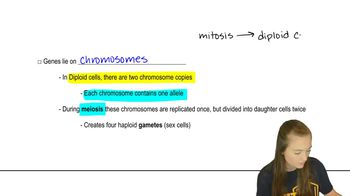A strain of E. coli is identified as having a null mutation of the RecA gene. What biological property do you expect to be absent in the mutant strain? What is the molecular basis for the missing property?
Table of contents
- 1. Introduction to Genetics51m
- 2. Mendel's Laws of Inheritance3h 37m
- 3. Extensions to Mendelian Inheritance2h 41m
- 4. Genetic Mapping and Linkage2h 28m
- 5. Genetics of Bacteria and Viruses1h 21m
- 6. Chromosomal Variation1h 48m
- 7. DNA and Chromosome Structure56m
- 8. DNA Replication1h 10m
- 9. Mitosis and Meiosis1h 34m
- 10. Transcription1h 0m
- 11. Translation58m
- 12. Gene Regulation in Prokaryotes1h 19m
- 13. Gene Regulation in Eukaryotes44m
- 14. Genetic Control of Development44m
- 15. Genomes and Genomics1h 50m
- 16. Transposable Elements47m
- 17. Mutation, Repair, and Recombination1h 6m
- 18. Molecular Genetic Tools19m
- 19. Cancer Genetics29m
- 20. Quantitative Genetics1h 26m
- 21. Population Genetics50m
- 22. Evolutionary Genetics29m
17. Mutation, Repair, and Recombination
DNA Repair
Problem 22b
Textbook Question
The SOS repair genes in E. coli are negatively regulated by the lexA gene product, called the LexA repressor. When a cell's DNA sustains extensive damage, the LexA repressor is inactivated by the recA gene product (RecA), and transcription of the SOS genes is increased dramatically. One of the SOS genes is the uvrA gene. You are a student studying the function of the uvrA gene product in DNA repair. You isolate a mutant strain that shows constitutive expression of the UvrA protein. Naming this mutant strain uvrAC, you construct the diagram shown above in the right-hand column showing the lexA and uvrA operons:
Outline a series of genetic experiments that would use partial diploid strains to determine which of the two possible mutations you have isolated.

 Verified step by step guidance
Verified step by step guidance1
Understand the problem: The uvrAᶜ mutant strain shows constitutive expression of the UvrA protein, meaning the gene is always active regardless of DNA damage. The goal is to determine whether the mutation is in the uvrA gene itself (e.g., in its promoter or operator) or in the lexA gene (which encodes the LexA repressor). Partial diploid strains can help distinguish between these possibilities.
Construct a partial diploid strain: Introduce a wild-type copy of the uvrA gene into the uvrAᶜ mutant strain. This can be done by introducing a plasmid carrying the wild-type uvrA gene. Observe whether the constitutive expression of UvrA persists. If the mutation is in the uvrA gene itself (e.g., in its operator or promoter), the wild-type copy will not suppress the constitutive expression. If the mutation is in the lexA gene, the wild-type lexA gene will restore normal regulation.
Construct another partial diploid strain: Introduce a wild-type copy of the lexA gene into the uvrAᶜ mutant strain. This can be done by introducing a plasmid carrying the wild-type lexA gene. Observe whether the constitutive expression of UvrA is suppressed. If the mutation is in the lexA gene, the wild-type copy will restore normal regulation. If the mutation is in the uvrA gene, the constitutive expression will persist.
Analyze the results: Compare the expression of UvrA in the two partial diploid strains. If the wild-type uvrA gene does not suppress constitutive expression but the wild-type lexA gene does, the mutation is in the lexA gene. If neither wild-type gene suppresses constitutive expression, the mutation is likely in the uvrA gene itself.
Confirm the findings: To further confirm the location of the mutation, sequence the uvrA and lexA genes in the mutant strain. Look for mutations in the promoter or operator region of uvrA or in the coding region of lexA. This will provide definitive evidence for the location of the mutation.
 Verified video answer for a similar problem:
Verified video answer for a similar problem:This video solution was recommended by our tutors as helpful for the problem above
Video duration:
1mPlay a video:
Was this helpful?
Key Concepts
Here are the essential concepts you must grasp in order to answer the question correctly.
SOS Response
The SOS response is a cellular mechanism in bacteria, particularly E. coli, that is activated in response to extensive DNA damage. This response involves the expression of a set of genes, including the uvrA gene, which are crucial for DNA repair. The process is regulated by the LexA repressor, which inhibits the transcription of these genes under normal conditions. When DNA damage occurs, the RecA protein facilitates the inactivation of LexA, leading to the upregulation of SOS genes.
Recommended video:
Guided course

Positional Cloning
LexA Repressor
The LexA repressor is a protein that negatively regulates the SOS response in E. coli by binding to the operator regions of SOS genes, preventing their transcription. Under normal circumstances, LexA maintains low levels of SOS gene expression. However, when DNA damage is detected, RecA binds to single-stranded DNA and promotes the autocleavage of LexA, thereby relieving repression and allowing for the expression of genes necessary for DNA repair, including uvrA.
Recommended video:
Guided course

Trp Repressor
Partial Diploids and Genetic Experiments
Partial diploids are bacterial strains that contain two copies of certain genes, typically achieved through the introduction of a plasmid or a second chromosome segment. This genetic setup is useful for determining the dominance or recessiveness of mutations. In the context of the uvrAᶜ mutant strain, constructing partial diploids can help elucidate whether the constitutive expression of UvrA is due to a mutation in the uvrA gene itself or in the regulatory lexA gene, allowing for a clearer understanding of the genetic interactions involved.
Recommended video:
Guided course

Diploid Genetics
Related Videos
Related Practice
Textbook Question
449
views


